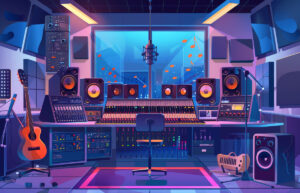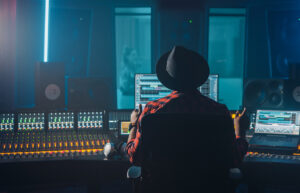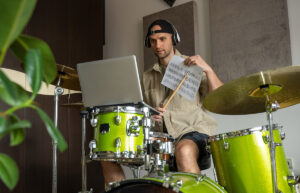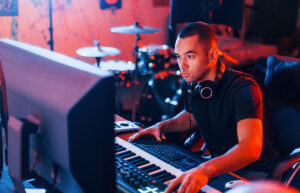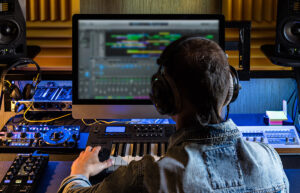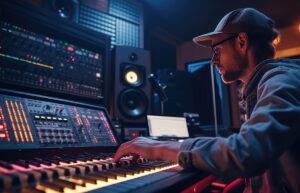How to Make Music: Meaning, Equipments, Process & Tips

In this guide, I am thrilled to share a beginner-friendly roadmap on how to make music and set you on the path to create your musical masterpieces. Whether you are stepping into the musical world for the first time or already feeling the beat, embark on your musical adventure using the tips presented in the guide.
Welcome to TheDemoStop, now join the community!
Connect with artists, fans and producers around the world.
What is music production?
Music production is the art of bringing melodies, rhythms, and lyrics together to create captivating and harmonious sounds. It’s the magic behind the scenes, transforming a song from a simple idea into a full-fledged aural experience. As someone deeply immersed in this realm, I would say it’s the art of assembling and refining different elements such as melodies, rhythms, and vocals to create compelling sound pieces. It’s not just about hitting records; it’s about shaping sound, manipulating audio, and bringing artistic visions to life.
From brainstorming ideas to recording, arranging, editing, and mixing, every step requires a blend of technical skills, creativity, and a keen ear. It’s about understanding the nuances of different instruments, mastering software, and knowing how to bring out the best in artists. Collaboration is key, and musicians, vocalists, and sound engineers work closely to produce harmonious compositions that resonate with audiences.
Moreover, music production is not restricted to a specific genre or style—it is a dynamic field embracing diverse sounds, from pop and rock to electronic, hip-hop, and beyond. In essence, it’s the magical process of transforming raw musical ideas into polished tracks that evoke emotions and captivate listeners worldwide.
Fundamentals of music
Understanding the basics lays a solid foundation for your musical journey. Here’s a breakdown of the fundamental elements that will set you on the right path:
Understanding musical notation
Familiarize yourself with the language of music. Learning how to read sheet music is akin to deciphering a musical code. It’s like learning to read a map to navigate the melodic landscape. There are plenty of online resources and beginner-friendly books that amplify this aspect, making it more approachable for newcomers.
Basic music theory
Embrace the fundamental principles of music theory. It’s not as intimidating as it may sound. Concepts such as scales, chords, and intervals form the building blocks of music. Websites as well as YouTube channels offer engaging tutorials that break down these concepts into digestible pieces. A good tutor can help as well.
Ear training
Developing an ear for music is crucial and involves recognizable pitches, intervals, and rhythms by ear. Numerous applications and online platforms are specifically designed to help you train your ear effectively.
Familiarizing with instruments and sounds
Exploring various instruments and their unique sounds widens your musical palette. Whether it’s the soothing strumming of a guitar or the rhythmic beats of drums, each instrument brings its own charm to the musical symphony. Various online resources provide insights into various instruments and their sounds.
Equipment required for making music
If you are stepping into the exciting world of music production, having the right tools is key to unleashing your creativity. Let me walk you through the essential gear you require to breathe life into your musical ideas:
Laptop/computer
A reliable laptop/computer acts as the heart of your setup. Ensure it meets software requirements and offers sufficient processing power. Connecting it to an audio interface lets you bring instruments and mics into your projects, offering endless sonic possibilities.
Digital audio workstation
A digital audio workstation (DAW) is your creative hub. Choose one that matches your workflow, offering efficient recording, editing, and mixing capabilities. Getting familiar with a reliable DAW considerably enhances project quality.
Audio interface
Audio interface is a crucial device for audio clarity. The interface transforms analog audio signals to digital and vice versa. This interface is the bridge between instruments, microphones, and your computer guarantees high-quality recordings.
Microphone
Microphone is a recording essential. Pick from condenser or dynamic types based on your needs and budget. Essential for vocals or acoustic instruments, choose one aligning with your recording style.
Mic stand
Often overlooked yet vital for proper microphone placement, ensuring stability and consistent sound quality across recording sessions. Select a stand suitable for your microphone’s size and weight.
Studio monitors
Studio monitors are for your ears. Opt for quality monitors with balanced frequency responses for seamless track mixing and mastering. You should be able to pick up your pitch and timber and adjust your tone accordingly. Audio clarity is essential not just for recording but also for sampling and subsequent listening and experimentation until the right sound is achieved.
MIDI controller
The MIDI controller is great for adding virtual instruments and controlling software parameters, adding versatility and expression to your compositions. Consider the number of keys, pads, and knobs based on your music style and performance requirements.
Welcome to TheDemoStop, now join the community!
Connect with artists, fans and producers around the world.
Software required to start making music
When delving into music production, having the right software is critical. Here are some stellar options that I highly recommend:
PreSonus Studio One 6
An intuitive and user-friendly platform suitable for both beginners and professionals. Studio One 6 offers a seamless workflow, drag-and-drop functionality, and numerous built-in virtual instruments, effects, editing, and mixing capabilities.
Steinberg Cubase Pro 12
Cubase Pro 12 boasts advanced MIDI tools, powerful audio editing features, and comprehensive mixing capabilities. Because of its professional-grade audio quality, Steinberg Cubase Pro 12 is used by elite artists.
Image Line FL Studio 21
A versatile DAW, FL Studio 21 is fantastic for electronic music creators and is renowned for its pattern-based sequencer, flexible workflow, a plethora of sound libraries, and an array of built-in instruments and effects.
Ableton Live 11
Popular among live performers and electronic music producers, Live 11 offers real-time performance features, flexible looping, and an array of sound-shaping tools perfect for experimentation.
Bitwig Studio 4
Emphasizing modularity and flexibility, Bitwig Studio 4 offers a hybrid DAW experience with extensive customization and a diverse range of innovative instruments and effects.
It works as an excellent choice for people who love to experiment and push creative boundaries.
Reason Studios Reason 12
Reason 12 is a powerhouse for sound creation and manipulation. The software package is renowned for its virtual rack of synths, wide array of instruments, and effects modules. Reason Studios Reason 12 allows users to incorporate several variations in the sound.
Apple Logic Pro
Exclusive to macOS users, Logic Pro is a comprehensive software package offering a vast library of virtual instruments, powerful editing tools, recording, and professional-grade mixing capabilities.
AVID Pro Tools
Widely used in the music industry, Pro Tools is known for its superior editing, mixing, and mastering capabilities, making it a staple in many professional studios. In my music making experience, AVID Pro Tools has proven to be more than adept for making music.
Process of music making
I break down music making into six basic stages to make up the magic behind the scenes:
Songwriting
Let your creativity flourish during songwriting! Craft fundamental elements, such as melody, lyrics, and chord progressions, of the song. Let out the musician in you. The soul of your music is shaped in this stage. Whether penning down heartfelt lyrics or crafting intricate melodies, the songwriting process is where the magic of music making truly begins.
Arranging
Focus on organizing and structuring the song elements – deciding when and how each instrument or vocal comes into play. It’s like setting the stage for your musical story. When the basic structure is set, arranging comes into play, determining how different sections of the song (intro, verse, chorus, etc.) will flow together to create the desired impact.
Tracking
Time to record! Instruments and vocals are recorded. Tracking involves recording individual instruments, vocals, or sounds layer by layer, meticulously crafting each element to build the aural landscape of your composition. It’s about getting that perfect take, ensuring each sound is crisp and captures the emotion intended during the editing phase.
Editing
Editing is all about refining. Post-recording, this phase involves refining individual tracks, adjusting timing, pitch, and deleting unwanted noise to achieve a clean sound. Editing empowers you to polish your work, iron out imperfections, and shape the final sonic landscape, ensuring a seamless and captivating listening experience for your audience.
Mixing
Mixing is where the magic happens! Mixing involves blending individual tracks and adjusting their levels, EQs, and effects to achieve sonic cohesion and clarity. Through a mixing console or software, you meticulously sculpt the sound, balancing elements like vocals, instruments, and percussion, ensuring each component contributes to the overall sonic landscape.
Mastering
The final touch! Mastering fine-tunes the overall sound, ensuring consistency and readiness for distribution across different platforms, and enhancing the overall quality and coherence of the track. It is during mastering that the tracks receive their final touches, ensuring they are optimized for various playback systems and formats, ready to captivate listeners’ ears with their perfect sound quality.
Welcome to TheDemoStop, now join the community!
Connect with artists, fans and producers around the world.
Tips for making music
Here are some key tips to elevate your craft:
Record music
Start by recording your musical ideas. Invest in decent recording equipment or software to lay down your tracks. Capturing your melodies, beats, or compositions allows you to revisit and refine your work, unlocking creativity and honing your skills. It serves as a tool for self-improvement, enabling you to analyze and enhance your performances, melodies, and arrangements.
Mixing
Mastering the art of music is crucial for achieving a professional sound. Start by understanding the balance between different audio elements, ensuring each instrument or voice finds its perfect place in the mix. Balancing volumes, adjusting frequencies, and fine-tuning the stereo is helpful. Experiment with effects, levels, panning, and equalization to create a harmonious blend that doesn’t overpower or get lost in the sound.
Adjust the equalizer
Use the equalizer (EQ) to fine-tune the frequency balance in your tracks. Learn to tweak frequencies to refine your sound. Enhance or reduce specific frequencies to achieve clarity and depth. Experimenting with the EQ settings gives you the flexibility to mold your music according to your creative vision, making it an indispensable aspect of your production process.
Use compression
Use compression to control the dynamic range of your audio. It helps maintain consistent levels and adds punch to your tracks. Compression helps you sculpt the fabric of your audio, imparting depth and clarity that resonates with your listeners. This technique is a powerful tool that ensures a balanced and polished sound.
Reverb
Reverb adds depth and ambiance to your sound. Experimenting with different reverb settings allows you to tailor the mood and atmosphere of your music, whether it is a subtle touch for warmth or a more pronounced effect for an ethereal vibe. Reverb acts as a sonic enhancer, adding depth and dimension to your track.
Focus on finishing
Finishing what you start is crucial. Don’t linger endlessly on a single piece; aim to complete and move forward. Prioritizing completion allows you to refine your skills, develop a workflow, and bring your musical ideas to fruition. This practice not only builds a sense of accomplishment but also enables you to learn and grow from each finished piece.
Know basic theory
Understanding music theory can immensely improve your compositions. Even basic knowledge can provide a solid foundation for your compositions. Familiarize yourself with scales, chords, and song structure for more intentional and effective music-making.
Common music production jobs
If you are curious about the diverse roles within music production, you have landed in the right spot. As a passionate music aficionado myself, I am thrilled to share a list of some prevalent jobs that keep the music industry grooving and evolving. I have graduated through various roles and enjoyed the journey thoroughly.
Music producer
As a music producer, you need to craft the overall sound and feel of a track or album. You will work closely with artists, guiding them through the creative process, overseeing recording sessions, and ensuring the final product aligns with the artistic vision.
Studio engineer
Studio engineers are the tech wizards behind the scenes. They manage the recording equipment, fine-tune sound levels, and ensure the studio operates smoothly, making the artist’s vision come alive through technical expertise.
Live sound engineer
When it’s showtime, sound engineers step in. They manage the sound systems during concerts or events, ensuring the audience enjoys high-quality audio by handling mixing, amplification, and sound effects in real-time.
Foley artist
Foley artists add depth and authenticity to audio productions by creating sound effects. From footsteps to creaking doors, they generate sounds in sync with visual cues to add effects apart from the music into the soundtrack.
Sound designer
Sound designers are responsible for creating immersive audio experiences. They manipulate and design sounds to evoke emotions, set moods, and add layers of depth to various media forms.
Radio producer
Radio producers curate and manage content for radio shows. From planning segments to coordinating with hosts and guests, radio producers ensure a smooth and engaging broadcast.
Radio engineer
Radio engineers ensure seamless transmission by managing broadcast equipment and maintaining the technical aspects of radio stations, guaranteeing that the sound reaches the listeners flawlessly.
Musical artist
As a musical artist, your role involves creating original compositions, writing lyrics, and performing your music. You take charge of the recording process, exploring diverse sounds and melodies to create a unique sonic experience that resonates with your audience. Additionally, you collaborate with producers and sound engineers to achieve the desired final product, ensuring your artistic vision comes to life in your tracks.
Welcome to TheDemoStop, now join the community!
Connect with artists, fans and producers around the world.
Conclusion
Creating music is a captivating journey that transcends boundaries and speaks to the soul. To summarize our musical exploration:
- Introduction to music production: Music production involves blending melodies, rhythms, and lyrics to craft captivating sounds. It is the art of shaping sound, manipulating audio, and bringing artistic vision to life.
- Fundamentals of music: Understanding musical notation, basic theory, ear training, and exploring various instruments form the bedrock of musical exploration.
- Essential equipment for music production: A laptop/computer, DAW, audio interface, microphone, mic stand, studio monitors, MIDI controller are essential tools for unleashing creativity.
- Software for music production: PreSonus Studio, Cubase Pro 12, FL Studio 21, Ableton Live 21, AVID Pro Tools, Bitwig Studio 4, Reason 12, Logic Pro, and various software are essential music production tools.
- Process of music making: Songwriting, arranging, tracking, editing, mixing, and mastering form the essential steps in crafting a musical masterpiece.
- Tips for music making: Recording, mixing, mastering, understanding EQ, compression, and reverbs elevate music production skills.
- Common music production jobs: Roles such as music producer, studio engineer, live sound engineer, foley artist, sound designer, radio engineer, and musical artist are vital in the music industry.
FAQs
What is music production?
Music production is the creative process of assembling melodies, rhythms, and lyrics to craft captivating sounds. It involves the manipulation of audio elements using technology and artistic skills, transforming musical ideas into polished tracks. This process encompasses various stages such as recording, editing, mixing, and mastering to create an excellent experience for listeners.
What is song writing?
Songwriting is the art of creating original music by composing lyrics and melodies that express emotions, stories, or ideas. It involves crafting catchy hooks, meaningful verses, and compelling choruses that resonate with audiences. It is a creative process that encompasses both poetic storytelling and musical composition to bring songs to life.
What is the process to make music?
The process of making music involves several key steps, such as songwriting, arranging, tracking, editing, mixing, and mastering.
What are the fundamentals of music?
The fundamentals of music include understanding musical notation and grasping basic music theory. Ear training and exploring diverse instruments and their unique sound are also fundamental aspects enriching one’s musical palette.
What equipment do you need to create music?
To craft music, essential equipment includes a reliable laptop/computer, a versatile DAW, an audio interface, quality studio monitors, and a microphone. These tools serve as the foundation, allowing musicians to record, edit, mix, and bring their creative musical visions to life.
What software is used to produce music?
Several software packages cater to music production, offering diverse tools and functionalities. Notable choices include PreSonus Studio One, Steinberg Cubase, Image Line FL Studio, Ableton Live, Bitwig Studio, Reason Studios Reason, Apple Logic Pro, and AVID Pro Tools.
How can you make good music?
Crafting good music involves attention to detail and creativity. Some of the essential tips include recording your musical ideas effectively. Dive into mixing to blend tracks seamlessly and utilize EQ to refine your sound’s frequency balance. Use compression for consistent audio levels and experiment with reverb for added depth. Lastly, be sure to finish what you start.
What jobs can you get in music production?
In music production, diverse job opportunities abound, including roles like music producer, studio engineer, live sound engineer, foley artist, sound designer, radio engineer, radio producer and live DJ.
How do beginners start producing music?
For beginners diving into music production, starting with a solid foundation is key. Begin by familiarizing yourself with the basics of music theory, understanding musical notation, and exploring various instruments and their sounds. Invest time in learning about essential equipment like a computer, DAW, audio interface, microphone, and studio monitors. Additionally, seek guidance from online resources, tutorials, and perhaps mentorship from experienced producers to kickstart your musical journey with confidence.


